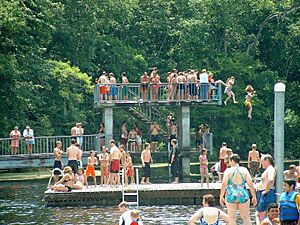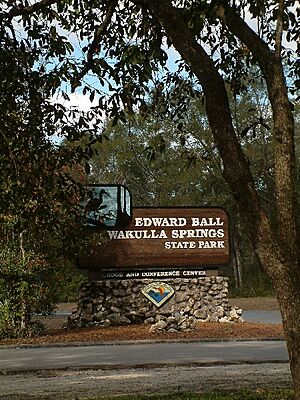Edward Ball Wakulla Springs State Park facts for kids
Quick facts for kids Edward Ball Wakulla Springs State Park |
|
|---|---|
|
IUCN Category V (Protected Landscape/Seascape)
|
|
| Location | Wakulla County, Florida, United States |
| Nearest city | Tallahassee |
| Area | 6,000 acres(24 km2) |
| Governing body | Florida Department of Environmental Protection |
| Designated: | October 1966 |
Edward Ball Wakulla Springs State Park is a huge state park in Wakulla County, Florida. It's a special place that protects wildlife and nature. The park covers about 6,000 acres (24 square kilometers). It is located south of Tallahassee.
This park is very important! It is listed on the National Register of Historic Places. This means it has historical value. It is also a National Natural Landmark, which means it has amazing natural features.
You can explore the park on three nature trails. These trails take you through pine forests and wet areas called bald cypress wetlands. You'll also see hardwood hammocks. Hikers, bikers, and even horse riders can enjoy these trails.
The park is home to lots of animals. In the forests, you might spot white-tailed deer and wild turkey. Many different kinds of birds live here too. In the springs, swamps, and river, you can see American alligators, bass, gar, and various snakes. In winter, West Indian manatees sometimes visit the warm waters.
The park is named after Edward Ball. He was a financial manager for the DuPont family. He sold the land for the park to the state of Florida.
Wakulla Springs: A Giant Underwater World
The park's biggest attraction is Wakulla Springs. This is one of the largest and deepest freshwater springs in the world! It's like a giant natural water fountain. The water comes from the Floridan Aquifer, which is a huge underground water system.
A lot of water flows out of Wakulla Springs. The most water ever measured was 860,000 gallons (54 cubic meters) per minute! On average, about 400,000 gallons (25 cubic meters) flow out each minute.
The opening of the spring is 180 feet (55 meters) deep. Brave cave divers explore the many miles of underwater tunnels here. Groups like the Woodville Karst Plain Project have mapped these amazing caves. The spring forms the Wakulla River, which flows south for several miles. It then empties into the Gulf of Mexico.
Ancient History at the Springs
People have been visiting Wakulla Springs for a very long time. Paleo Indians camped here about 12,000 years ago. They hunted huge animals like mastodons and bison.
The bottom of the spring bowl is full of ancient bones. You can find bones from mastodons, giant sloths, giant armadillos, and even camels. You can often see these bones on glass-bottom boat tours. These tours operate all year, letting you peek into the spring's clear waters.
Scientists have found 54 archaeological sites in the park. These sites show that many different groups of people lived here over thousands of years. They found tools and items from the 20th century, Seminole people, and older cultures like Fort Walton culture, Weeden Island culture, and Norwood culture. They also found items from the Archaic and Paleoindian times.
Other cool natural spots are also in the park. These include Sally Ward Spring and Cherokee Sink. Nearby is the Leon Sinks Geological Area, which is part of the same underground cave system.
The park also has the Wakulla Springs Lodge. This historic building works as a hotel for visitors.
Fun Things to Do at the Park
There are many fun activities at Edward Ball Wakulla Springs State Park:
- Birdwatching: You can spot many different kinds of birds.
- Boat Tours: Take a boat tour to see the spring and river. Sometimes, you can even go on a glass-bottom boat tour!
- Hiking: Explore the park's trails on foot.
- Horse Trails: If you have a horse, you can ride on special trails.
- Picnicking: Enjoy a meal outdoors in the picnic areas.
- Snorkeling and Swimming: On hot days, you can cool off by snorkeling or swimming in the spring.
- Wildlife Viewing: Look for all the amazing animals that live in the park.
The park also has an exhibit to teach you more about the area. There are also concessions where you can buy snacks.




